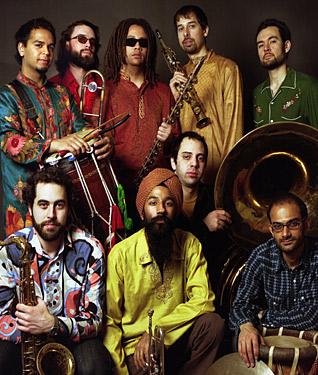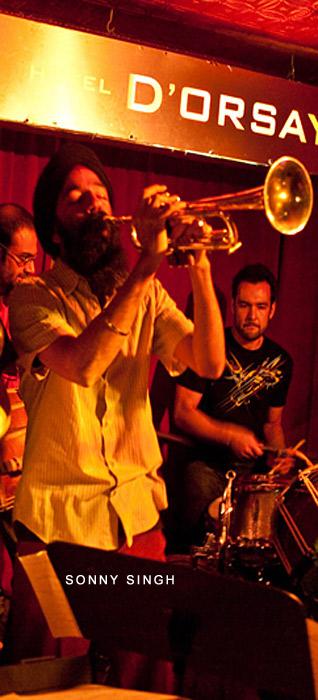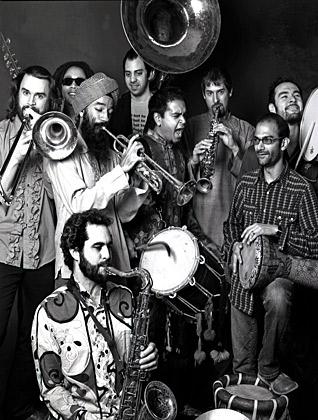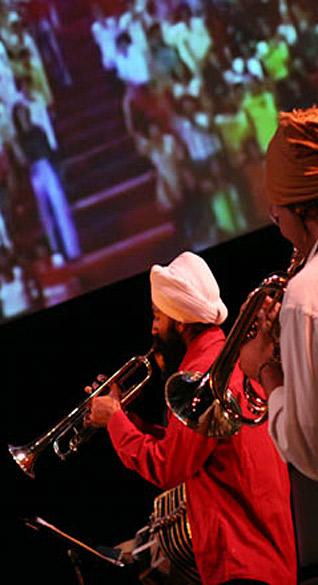Music
Red Baraat:
Bhangra, Brass and Bringing It
An Interview by TAZ
Bumping beats to rearrange heart beats, Red Baraat is “Hoi, hoi-ing” into the hearts of people across the nation. Established in 2008, this nine member New York City based “dhol ‘n’ brass band” has quickly risen to the top in the ‘world music’ circuit (and wedding circuit) of the NYC area. Red Baraat is now taking it outta The City with their first new album, Chaal Baby, set to drop January 2010 and a Midwest tour scheduled in Madison, Milwaukee and Chicago for Sep 17-20, 2009.
 
AN INTERVIEW WITH SONNY SINGH & SUNNY JAIN
1. How would you describe Red Baraat’s music?
Sunny: Well, the sound of the band is based on acoustic instruments bringing a powerful primal sound: dhol, percussion, sousaphone and several horns. While the foundation is North Indian Bhangra, there is a multitude of musical elements clashing together, such as funk, hip-hop, go-go, rock, jazz, Latin. Also, there’s a good deal of vocal interaction with the audience, from Punjabi singing, to English rapping, to group call-and-responses.
2. Traditionally, baraat bands are found in North India leading wedding processions to festivities. How do you think ‘fusion’ has played a role in ‘Americanizing’ your sound?
Sunny: While Red Baraat aims to bring the festive vibe found in North Indian wedding processions, our sound is naturally an American and/or fusion sound, since the majority of the band grew up here. There are a variety of ethnic, cultural and musical backgrounds that make up Red Baraat and it is only fitting to let these assortments of flavors enter into our group sound. It is because of each individual player in the band that we sound like we do.
Sonny: Music is always about fusion in one way or another, and I don’t think there’s such thing as “pure” music, or “pure” culture for that matter. I’d say we’re intentional about our mash up of different musical traditions and styles for sure.
3.Do you guys perform at weddings?
Sunny: The band actually had its birth at my wedding 4 years ago when 30 of my musician friends brought me in playing typical baraat music and music I had also written for the occasion. Shortly after that, I started getting calls in the NYC-vicinity to perform at baraats in town. It’s been 3 full seasons now that we’ve been playing weddings and this year alone we’ve performed at nearly 40 of them.
Sonny: A typical Red Baraat baraat gig starts with waking up at 7am or earlier on a Saturday morning, meeting Sunny at a random corner in Brooklyn, getting some bagels/ tea/ coffee, and then driving to the burbs of jersey or long island to rock for the aunties and uncles. The wedding gigs are kind of intense, as my head often feels like it’s going to explode by the end from playing as loud as I can nonstop. Once the groom gets off the horse, we go back to Brooklyn.
4. What is the story behind how the band first started?
Sunny: The band now known as Red Baraat has been performing publicly for less than a year. While a smaller version of the group has been doing weddings for 3 years now, I didn’t decide to make this a public band until summer of 2008.
Sonny: It’s been awesome working with Red Baraat since the early, pre-public days. Sunny and I met 4-5 years ago through a great Hindustani classical vocalist Samita Sinha who we were collaborating with. Sunny called me to do baraat gigs back when I was playing full-time with another band. But it’s been really exciting that it’s turned into a full-on band in this last year and is my main musical outlet now.
5. You have a talented array of band members…Sunny, how did you find them?
Sunny: I knew all the members of Red Baraat from various playing situations. I was specifically looking to mix it up with various musical backgrounds so that we could have versatility in composition and performance. Each member has such a unique voice they bring to the group…Rohin Khemani (tavil, doumbek, percussion), Tomas Fujiwara (drumset), John Altieri (sousaphone, rap), Arun Luthra (soprano sax, solkattu), Sonny Singh (trumpet, vocals), Dave Smith (trombone), Mike Bomwell (baritone sax), Mike Williams (bass trumpet) and myself (dhol, drumset, percussion, MC).
6. Sunny, you made your professional debut as a dhol player in the Broadway musical Bombay Dreams and you have a long list of credits as a jazz drummer. How did you get your start in music?
Sunny: I remember at age 3 or 4 air-drumming (or air-tabla’ing) to Jain Bhajans, Bollywood, and Top 40 music. I started drum lessons at age 10 and have always been interested in checking out and playing all types of music. I got turned onto jazz by my drum teacher at age 13 and was drawn to the rhythms and depth of the music. I knew at age 17 I wanted to make my living as a musician and since then I’ve been very fortunate to be able to play with some great names in jazz, and then turn around and perform with the sufi-rock group Junoon, and then play on Broadway. I think it’s my penchant for change that propels me to play drumset, dhol, percussion and in various styles: jazz, rock, Indian music, Afro-beat, singer-songwriter, drum ‘n’ bass, etc. I like to mix it up.
7. Sonny, I feel like you got your start in music from more the ska and punk side - your first band Turban Jones had a 90s ska/punk sound. How do you think your involvement with music has evolved over the years?
Sonny: When I really think about it, I got my start in music from playing kirtan (Sikh devotional music) in gurdwaras and at Sikh camp when I was really young - playing harmonium and singing and playing tabla. I think I was learning kirtan even before I first touched a trumpet in the 5th grade. But I stopped playing kirtan when I got older and found another calling in the ska scene in Arizona in the 90s. I really came up in the ska and reggae scene … something about the vibe of ska really spoke to me and to date it’s my favorite music to dance to.
When I moved to NYC in 2003 I think I slowly, very slowly, started getting back in touch with playing south asian music. I brought some of that to Outernational, melodically and instrumentally, learned the dhol, and now it’s all coming together in Red Baraat in a new way. This band is much more musically desi than any other band I’ve played in but in this way that people who don’t know anything about Punjabi music or bollywood love too. But for the record, my parents LOVE Red Baraat.
8. Sonny, recently you jumped on stage with The Kominas at a recent fundraiser show in Harlem. What was that experience like?
Sonny: It was funny because Basim (from The Kominas) called me up and told me to come and bring my trumpet. We talked about it briefly and agreed that I’d come sit in for one song at the end of the set. Then as soon as they started playing, Basim makes trumpet gestures at me and I went up there and ended up playing with them for the entire set. We blew out the speakers. Enough said.
9. It was a unique collaboration, what do you have to say about the importance of inter-South Asian/ inter-faith collaboration through music?
Sonny: These tensions that exist between our communities in South Asia and in the diaspora are very real, but I think our generation really needs to make some serious breakthroughs. As a turban-wearing Sikh, I have a very conspicuous spiritual/ religious identity, so in that sense, I hope it does send a clear message of solidarity and unity when people see me playing with the Kominas.
I also hope it makes people think about their notions and assumptions about Islam and Sikhi and the walls that are often falsely constructed around these faiths and their followers … Furthermore, Sikh-Muslim solidarity and collaboration in particular is so important in the post-9/11 environment of global Islamaphobia and Arab-hating. The demonizing of Muslims is a big part of why Sikhs face the kind of discrimination and bigotry we do in this country … Artistic collaboration perhaps is one way to move more in this direction.
10. Sonny, you also work at the Sikh Coalition and your past music has a strong political undertone - what are your thoughts on music as a tool for politics?
Sonny: Yeah, I’m a community organizer at the Sikh Coalition in New York City, working to build a movement of Sikhs fighting for equality and social justice. It’s cool to see the overlap that sometimes exists between my day job as an organizer and my musician life in Red Baraat … Red Baraat is not an explicitly “political band,” but I think nevertheless has an important role in our collective struggles for liberation and social justice. Celebratory music that brings people joy in a world filled with oppressive violence is so important in keeping us hopeful that change is not only possible, but inevitable … if we keep organizing and dreaming and struggling.
11. Both of you guys dabble in a range of genres of music but with Red Baraat it sounds like you are pushing the boundaries of how ‘musical genres’ are defined. What are your thoughts on inter-genre musical collaboration, if you can call it that?
Sunny: It’s like what Duke Ellington once said: “There’s only two types of music: good music and bad music.” We’re just trying to play some good music and bring an energy that audiences can latch onto. It’s been great sharing the stage with the various groups we have and I hope to continue doing that with some indie-rock bands as well. I think the whole “inter-genre” musical billing exposes the audience to new music and exposes a band to a new audience. I think that’s great!
Sonny: You think about any innovative and powerful music that has been created throughout human history and it’s always been the result of blending and mixing and pushing boundaries.
Red Baraat has a huge string of shows coming up in the Midwest for World Music Festivals, I believe the first ever for your group? How do you think Red Baraat will be received outside of NYC?
Sunny: This is indeed our first tour and we are psyched. We’re just going to do what we do and bring the energy and excitement we unleash in our live shows and hopefully people will take to it. We’re definitely looking forward to our billing with Cheb I Sabbah in Chicago.
Sonny: I’m looking forward to eating some frozen custard in Wisconsin.
12. Though I’ve never seen you perform, I get the feeling from the youtube videos that is a completely different experience to watch your show live than on CD. What have been your favorite live performances?
Sunny: Each performance is different and special depending upon the venue, the audience, our setup and whatever random conducting I may do … For instance, playing outdoors at Lincoln Center as a marching band and adding some dramatic movements was fun for us. Then 6 days later, we took the stage at DJ Rekha’s Basement Bhangra and played a tight, crazy high energy 30-minute set. When we play at our monthly spot in Brooklyn, Barbes, we stretch a little more and I have a little more fun with impromptu conducting.
13. What do you think it is about your songs that draw people together?
Sunny: I think it may be the various musical styles that pop out in the music that appeal to people. I think there’s something about acoustic instruments playing with such power and energy that strikes people at the core. Not to mention, the sound of the dhol is so unique and people can’t help but like it.
Sonny: I think people feel the energy. There’s something particularly celebratory about our vibe that I think people connect with. I agree about the dhol too. My friend Sujot once told me, “Like the djembe, the dhol is the heartbeat of a people.” I think people feel it, not just hear it.
14. Who are some of your favorite artists right now that you think people should keep an eye on? Your favorite song and/or CD of the moment?
Sunny: I jump around a lot from The Beatles, to Radiohead, Sufjan Stevens, Nikhil Bannerjee, Nitin Sawhney, Deerhunter and Squarpusher. I have been also revisiting some of the old classic Raj Kapoor songs. My dad used to listen to that often and I just love the melodies of older Bollywood movies…50’s, 60’s.
Sonny: Lately, I can’t stop listening to this 67-song Sufi collection I got in Punjab earlier this year. I’m pretty hooked on qawwalis … Nusrat of course, Wadali Brothers, Abida Parveen, etc. Other favorites include Ojos de Brujo, Ozomatli, Asian Dub Foundation, The Clash, Manu Chao, The Specials, 60s ska, RATM …
15. Final question, you have a cover of the infamous Tunal Tunak Tun - will you be making a tunak tunak tun music video resembling the original?
Sunny: Ha, ha … no plans yet, but who knows where things will go. Perhaps an animated version of the band playing it! I’m actually looking for a video animator if there’s anyone interested?
Sonny: I’m not dressing like Daler Mehndi.
[Courtesy: sepiamutiny.com. Photos by Amy Touchette.]
September 11, 2009
Conversation about this article
1: Ramneet (New York, U.S.A.), September 10, 2009, 8:32 PM.
Simply amazing :)
2: Parmjit Singh (Canada), September 11, 2009, 2:36 AM.
Sonny bro, I proudly showed videos of your high energy performances with Outernational to my very young kids years ago. You were an awesome force then and I wondered where you disappeared to. You're still awesome, along with your new band, and looking beautiful, bro! A social activist, independent thinker, soulful musician, and a Sikh true! Wow, what an inspiration!
3: Suzy Kaur (Oxford, England), September 11, 2009, 7:58 AM.
A Sikh singer from London who goes under the stage name of Jay Sean is at number 2 in the American Billboard charts at the moment. Is there any reason why you haven't featured him on your site?
4: Gurpal (Wolverhampton, U.K.), September 11, 2009, 4:31 PM.
Hmmmmm, Suzy ... You've got me thinking. You've asked if there is any reason why Jay Sean hasn't been covered by sikhchic.com. Possibly becasue the average American or Sikh-American probably wouldnt hear the name 'Jay Sean' and think 'Sikh' immediately. Can understand why Kamaljit Singh Jhooty has to change his name to achieve success in mainstream music, but knowing him, why the need to move so decisively away from his roots? Has he a connection with the Sikh community or any interest in its issues? At least Sonny 'Singh' sounds Sikh, has a Sikh appearance, interest in kirtan and concern with Sikh issues alongside work with the Sikh Coalition. I'm not saying that Jay Sean is less worthy of appreciation through sikhchic.com, he isn't. I'm saying it makes it easier in Sonny's for Sikhs to take an active interest in his work. People who don't know Jay Sean could hear his name, see his face and just assume he is mixed-race African-American or Hispanic.
5: Baljit Singh Rihal, J.P. (London, U.K.), September 11, 2009, 4:56 PM.
Absolutely fantastic ! Hope to see Red Baraat touring the U.K. soon.






